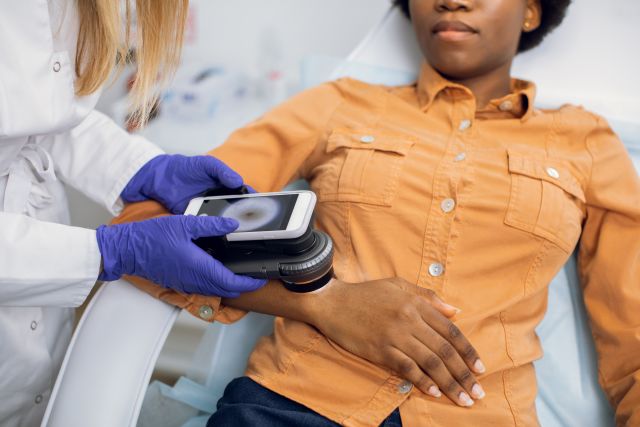Updated on April 10, 2025.
Skin cancer is the most common form of cancer in the United States, according to the Centers for Disease Control and Prevention. Despite better screening methods, more public awareness, and more advanced treatments, the rates of skin cancer continue to rise.
The deadliest form of skin cancer is melanoma. Each year in the United States, about 100,000 people are diagnosed with melanoma, and around 8,000 people die of the disease.
The good news is that skin cancer is treatable when it’s caught early. That’s why it’s critical to be aware of its early signs.
Skin cancer basics
Skin cancer is the irregular growth of skin cells, resulting from damaged genetic material that causes cells to change and grow out of control. Skin cancer can be caused by both lifelong sun exposure and quicker, more intense exposure to harmful ultraviolet (UV) rays—like when you get a bad sunburn. Anyone can develop skin cancer, but it’s more common in people with light or fair skin, blonde or red hair, and green, grey, or blue eyes.
There are three main types of skin cancer.
Basal cell carcinoma (BCC)
This is the most common form of skin cancer. These cancers usually develop on the head, neck, or arms, but they can also show up on the chest, stomach, or legs. BCC used to be most common among older people, but is now seen often at younger ages, due to tanning-bed use and increased time in the sun.
Squamous cell carcinoma (SCC)
SCCs are the second most common type of skin cancer. They frequently appear on the nose, ears, and lips. SCCs are twice as common in men compared to women and typically appear in people over age 50.
Melanoma
Genetics play a significant role in melanoma risk. But indoor tanning beds and prolonged exposure to the sun’s damaging UV rays also increase risk, especially if you had a severe sunburn during childhood. Melanoma occurs in stages, depending on how widespread it is in the body. The more advanced the stage, the deadlier the melanoma, which is why it’s important to get a diagnosis early and begin treatment quickly.
Skin cancer signs and symptoms
Each type of skin cancer has certain specific signs and symptoms.
Basal cell carcinoma
Signs can include pearly white or skin-colored bumps that may look like a pimple, says Andrea Murina, MD, a dermatologist in New Orleans.
“What makes it different from a pimple is that it doesn’t heal or go away and tends to bleed very easily,” she says. BCCs will also often have a sore or crust on them and may be mistaken for a scar.
Squamous cell carcinoma
SCCs typically show up as thick, scaly patches that can crust and bleed easily, says Dr. Murina. These areas tend to be persistent and won’t go away on their own. They can look like warts or appear as open sores with raised edges and a discolored middle.
Melanoma
The most common sign of melanoma is a mole, bump, or blemish that starts to itch, bleed, change color or shape, or increase in size, says Murina. While they can occur anywhere on the body, more common sites for men are the head, neck, back, and torso. For women, common locations are the arms and legs.
Use the ABCDE rule to help determine whether a mole may or may not be a melanoma:
- Asymmetry: Does one half of the mole look different in size or color than the other?
- Border: Is the edge of the mole rough, bumpy, blurry, or irregular?
- Color: Is the color different across the mole? Does it include patches of pink, white, red, blue, black, or brown?
- Diameter: Is the mole about the size of a pencil eraser or larger? (Keep in mind that sometimes melanomas can be smaller than this.)
- Evolving: Is the mole changing in size, shape, or color?
How to do a self-exam
One of the best ways to catch skin cancer early is by doing a monthly skin cancer check.
“Get undressed and use the mirror to examine current moles and freckles,” Murina says. “Look for changes or new spots that you haven’t seen before, and make sure that the spots you do have are staying the same or are similar to what you remember. Any bump, mark, or blemish that changes over time or isn’t healing should be checked out by a dermatologist.”
Ask your dermatologist to look at any concerning spots and have your skin examined according to the schedule they recommend. You may need more frequent exams if you have certain risk factors like an impaired immune system, a light complexion, a family history of skin cancer, or a past skin cancer diagnosis.
Should you get routine skin cancer screenings?
The U.S. Preventive Services Task Force (USPSTF) is an independent group that provides recommendations for health care. They haven’t found sufficient evidence to support routine skin cancer screenings. That doesn’t mean they advise skipping your annual or six-month skin cancer check. They simply don’t have enough evidence to declare that the benefits of regular skin cancer screenings outweigh the risks for everyone.
During a screening, your healthcare provider (HCP) will use a special lighted magnifying glass to look over your skin for any new or changing spots. If they find a suspicious spot, they’ll take a biopsy (a small sample of tissue) to look at under a microscope. While considered safe, the procedure may lead to some anxiety and could potentially cause a scar.
Talk with your HCP about whether you should have routine skin cancer screenings, and what your insurance covers.







